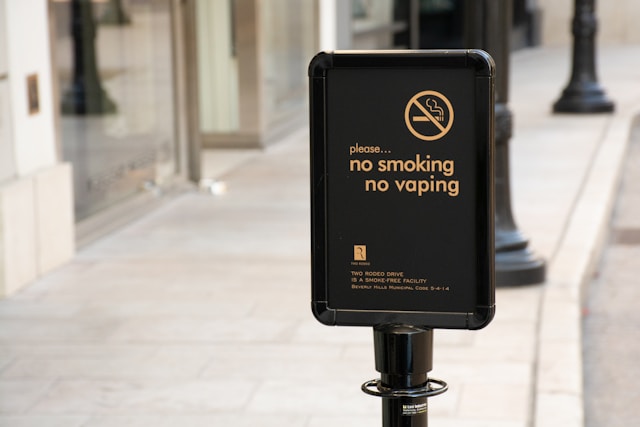For anyone under 18, it is illegal to purchase tobacco and e-cigarette products in most countries around the world. However, that has not stopped underage children from using these products, with vaping among kids and teens continuing to be a rising trend alongside extensive vape usage among adults, raising serious public health concerns.
Kicking any habit can be a complex and challenging process, and many health experts believe that nicotine addiction is one of the most difficult habits to break. However, reaching out for professional help through establishments like Quit Clinics is the first step to freeing yourself from a crippling addiction.

What are E-Cigarettes?
E-cigarettes, or vapes, are small, handheld, battery-powered devices that contain a flavored liquid that is heated into a vapor and inhaled like a regular cigarette. The liquid contains a variety of ingredients, including tobacco-derived nicotine, flavorings, and propylene glycol, among others.
Most types of e-cigarettes consist of a cartridge, tank, or pod that stores liquid (which can be refillable), a heating element that turns the liquid into a breathable vapor, a battery to power the device, a power or control button (unless it uses a sensor that activates when you inhale), and a mouthpiece.
Many smokers believe that switching from traditional cigarettes to vapes or e-cigarette devices is a healthier alternative to their bad habit. And while regular cigarettes contain a wide range of deadly toxins and chemicals not found in vape alternatives, they still hold their own range of harmful effects and impacts on your health.
What is in Vaping Liquid?
The vaping liquid, a key component of e-cigarettes, is a mixture of nicotine, propylene glycol (a colorless and odorless liquid with a sweet taste), and various flavors and chemicals. These ingredients are responsible for the familiar and enticing flavors of vape liquids. However, it’s important to note that many of these aerosol ingredients have not been evaluated by the FDA, which means they cannot be deemed tested and safe.
The most popular flavors of e-liquid, which range from fruity and candy flavors to chocolate and peppermint, are specifically designed to appeal to a younger crowd and are used to blanket more harmful effects on the human body. In a 2021 study, it was established that alongside nicotine, many e-liquids often contain ultrafine particles, which can be inhaled deep into the lungs, a chemical named diacetyl, which has been linked to lung disease, numerous heavy metals like nickel tin and lead, and other carcinogenic agents.
Vaping vs. Traditional Cigarettes
Vaping and cigarettes both involve users inhaling nicotine and other substances into their lungs. The most significant difference lies in the way this nicotine is consumed. Vape devices heat e-liquids until they become aerosol, while traditional cigarettes burn tobacco, which causes smoke.
Vaping is often considered to be a safer alternative to cigarette smoking. And in some instances, this is largely true. However, both products are highly addictive and introduce potentially dangerous chemicals into the body. The levels of these harmful chemicals are higher in tobacco compared to e-liquid, but vaping has not been around long enough to fully understand its true effect and the long-term damage it could cause. If you’re considering exploring vaping as an alternative, visiting a reputable Vape Shop in Winnipeg for guidance and high-quality products is important.
Health Risks
E-cigarettes and other vaping products can pose serious health risks when used for long periods of time, especially for those who suffer from pre-existing health conditions.
Lung & Heart Damage
Ongoing research continues to show that smoking e-cigarettes and related devices can cause significant lung damage and injuries. For example, nicotine is a potent and highly addictive vasoconstrictor or a blood pressure-increasing drug. Vaping delivers the nicotine found in e-liquid very quickly into the body, which can pose a severe risk to the heart and lungs.
Breathing in the vapors emitted from these devices can increase a range of severe side effects that doctors are only beginning to understand fully, including respiratory irritation and lung disease, an increased risk of heart disease, an increased risk of cancer, an elevated risk of bloody cots, particularly for those taking certain forms of birth control, and chronic breathing issues.
Nicotine Addiction
In a 2017 study published in the American Journal of Public Health, nearly 99% of all e-cigarettes sold in the US alone contain nicotine, even if it was not listed as an official ingredient on the label.
Nicotine is a highly addictive stimulant drug that causes a euphoric rush of endorphins or feel-good chemicals into the body, increasing the speed of messages traveling between the body and the brain. It also triggers an increase in dopamine levels, a neurotransmitter that further encourages the habit of vaping.
Due to its highly addictive nature, the effects of nicotine withdrawal can be extremely difficult to navigate and manage. These symptoms often include irritability, anger, difficulty concentrating, depression, restlessness, insomnia, anxiety, and an increased appetite. There has always been a level of social stigma attached to smoking. Vaping was initially seen as less antisocial, but the rise in vape detectors in public places has helped to create this stigma for vaping too.
https://unsplash.com/photos/red-and-black-box-mod-M8CrCzlS78Y
EVALI
EVALI is a term used to refer to a lung injury associated with e-cigarette and vaping product use. This serious lung condition is caused by excessive and/or prolonged vape usage, with Vitamin E acetate believed to be the cause.
A widespread outbreak of EVALI in the latter half of 2019 and early 2020 caused thousands of people to end up in hospital, with at least 68 people eventually dying. EVALI cases have since seen a decline. However, anyone who uses a nicotine or THC vaping device is at risk of developing this potentially deadly ailment.
Symptoms of EVALI include a persistent cough, shortness of breath, vomiting, stomach pain, an elevated heartbeat, chest pain, and a fever.
















Add Your Comment